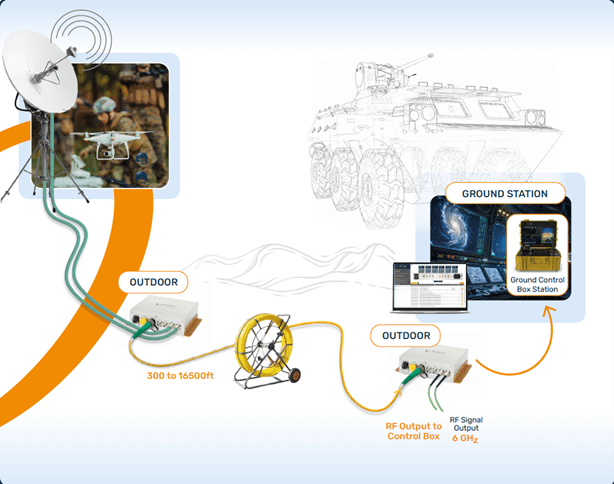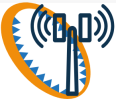
RF over Fiber for Ground Station Drone
In the rapidly advancing field of unmanned aerial vehicles (UAVs) and drones, effective communication between the drone and ground control stations is critical. RFOptic’s RF over Fiber (RFoF) technology offers a robust solution for antenna remoting, allowing for improved range, signal integrity, and operational flexibility.
Why use RF over Fiber and not coax in ground station drone solutions?
RF over Fiber technology eliminates the limitations of traditional coaxial cables, such as signal loss over distance and susceptibility to electromagnetic interference. RFoF provides lower noise figures and higher gain, making it ideal for long-range communication. Additionally, the lightweight and compact nature of fiber optics facilitates easier installation and maintenance in remote locations.
Key characteristics for ground station drone applications
The system supports bidirectional communication for all drone signals, featuring a low-noise front end with 30dB gain in receive mode and a high-power transmitter for extended range. Antenna remoting can occur from 10 meters to several kilometers, with outdoor rugged enclosures ensuring durability. The implementation of low-cost, expendable fiber interfaces, along with precise amplitude control with 31.5dB and 0.5dB step attenuators, further enhances system reliability.
Frequency range & RF coverage
Designed to operate within the 4 to 6 GHz frequency range, the RFoF system can be customized for other ranges, accommodating up to 12 GHz and 18 GHz when necessary. This flexibility allows the system to cover the full bandwidth commonly used by UAV controllers, optimizing communication for various applications.
Ground station drone application & design
The RFoF technology is particularly beneficial for UAV applications, providing high dynamic range and bi-directional support for remote antenna setups. By distancing the antenna from the operator, the system mitigates risks associated with emissions while delivering essential flight control signals over a single-mode fiber. Drones transmit their downlink signals, including video and reconnaissance data, in real-time back to the control center, ensuring a comprehensive data link.
Description of the RF over Fiber system (example).
The deployment integrates a 1U removable rack mounted in the ground station van, interfacing with the spectrum analyzer and RF source. On the drone side, a compact box containing an RF over Fiber transmitter is connected via armored optical fiber. This configuration ensures reliable communication and signal integrity, even in challenging environments.
RFoF Monitoring & Control
The system supports built-in diagnostics and remote monitoring capabilities, allowing for real-time oversight of signal integrity and performance. Ethernet signaling can be integrated into the same fiber connection, providing necessary network connectivity for equipment management at remote antenna sites.
Deployment
The deployment of the RFoF system involves easy installation of the 1U rack in the ground control station, ensuring quick setup and mobility. The compact box on the drone, with its integrated RF over Fiber transmitter, facilitates secure and reliable communication via single-mode fiber. This arrangement allows for flexible repositioning during various operation scenarios while maintaining signal quality.
Conclusion
RFOptic’s RF over Fiber technology represents a transformative solution for UAV and drone communication, addressing the challenges of traditional coaxial systems. With enhanced range, reduced signal loss, and the integration of advanced monitoring capabilities, this system stands out as the ideal choice for engineers seeking reliable and efficient antenna remoting solutions in the evolving landscape of aerial technology.
Contact Us









